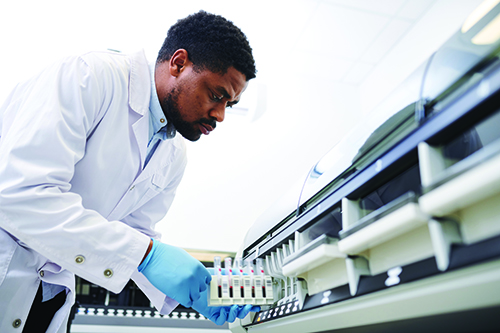
Leftover specimens are valuable resources for medical and translational research. The Food and Drug Administration (FDA) defines a leftover specimen as “the remnant of a human specimen collected for routine clinical care or analysis that would otherwise have been discarded.” An extended description could also include specimens obtained from repositories or biobanks and remnant specimens previously collected for other, unrelated research. The specimen types include, but are not limited to, biofluids such as serum or plasma, saliva, urine, and CSF, as well as tissues.
How Can Laboratories Use Leftover Specimens?
Clinical laboratories routinely use leftover specimens for quality improvement and method development, validation, and verification purposes. For researchers, leftover specimens can be a springboard to carry out pilot studies and test novel ideas. IVD manufacturers also use them to generate data in support of premarket submissions to regulatory agencies.
Leftover specimens are particularly precious in vulnerable patient populations such as pediatric, elderly, and pregnant patients, from whom an extra blood draw for research could be challenging or sometimes impossible. For example, an isobaric tags for relative and absolute quantitation technique was employed to reveal the proteomic changes in leftover sera from pregnant women suspected for developing preeclampsia (Hypertension Research 2020; doi:10.1038/s41440-020-0484-3); potential miRNA markers were discovered for ectopic pregnancy using leftover samples from pregnant women visiting the emergency room (Clinical Chemistry 2012; doi: 10.1373/clinchem.2011.179283); leftover specimens from pregnant women were used for quantifying nine antimicrobials and studying the exposure of pregnant women to antimicrobials (Journal of Clinical Laboratory Analysis 2021; doi:10.1002/jcla.23539); and distinct antibody responses to SARS-CoV-2 were identified in children using their leftover specimens submitted as part of routine care (JAMA Network Open 2021; doi:10.1001/jamanetworkopen.2021.4302).
Under certain situations, such as the COVID-19 pandemic, scientists are eager to obtain specimens from patients to study the molecular mechanisms and pathophysiology of the disease. However, prospective patient recruitment and sample collection for research could be impermissible, especially in patients under urgent care in the emergency room (ER) and critically ill patients in the intensive care unit (ICU) due to risk of infection and contamination. Moreover, longitudinal samples from those patients are extremely difficult to obtain even during non-pandemic times. Alternatively, as ICU patients’ blood work is performed daily as part of routine clinical care, longitudinal specimens are available after routine testing is done.
Using leftover specimens for COVID-19-related studies could dramatically accelerate medical research. In one study, we used longitudinal, leftover serum specimens obtained on the first, second, and third day of hospital stays and identified distinctive cytokine signatures that predicted the development of acute respiratory distress syndrome, acute kidney injury, and mortality in COVID-19 patients (Scientific Report 2021; doi:10.1038/s41598-021-91859-z). In another study, early antibody responses were evaluated in leftover sera obtained from 120 COVID-19 adult ER patients (Biosensor and Bioelectronics 2021; doi:10.1101/2020.11.19.20235044). We found that higher baseline SARS-CoV-2 total antibody and neutralizing antibody activity positivity rates and more robust antibody responses were seen in patients who survived COVID-19 than in those who died in the hospital.
Laboratories also can use archived specimens from previous, unrelated studies and repositories or biobanks for method development and biomarker evaluation. For example, at the beginning of the pandemic, there were a lot of controversies over test accuracy, particularly specificity of the SARS-CoV-2 antibody assays. The specificity validation could be achieved using archived specimens collected prior to the pandemic.
Regulatory Considerations
Although using leftover specimens usually does not involve direct patient interaction or intervention, they still should be deidentified, saved, and used for research purpose only with meticulous control and care to protect patients’ privacy and confidentiality. A careful evaluation should be made to determine whether the activity qualifies as research involving human subjects that must be reviewed by an institutional review board (IRB), and whether informed consent or the documentation of informed consent can be waived. Researchers in the U.S. can use “Human Subject Regulations Decision Charts: 2018 Requirements,” created by the U.S. Department of Health & Human Services, or consult the IRB with study specific details.
For leftover specimens obtained from clinical laboratories, researchers should recognize compliance requirements and policies to which these laboratories must adhere, such as how long patient samples must be kept before research or other uses. Researchers should coordinate with the clinical laboratory to obtain the specimens as soon as possible while remaining in compliance with the clinical laboratory’s policy.
Limitations
Using existing leftover specimens might sound like an easier approach than conducting prospective collection from study participants. However, their use often is limited in scope because they have not been collected for specific research purposes. In some cases, it is not possible to find sufficient demographic, diagnostic, and clinical information to determine whether leftover specimens are within the intended use.
Among other considerations, researchers must define clear scientific requirements when designing a study using leftover specimens. Researchers should determine if the quality and associated existing demographic and clinical data of the leftover specimens fit within the scope of the proposed study and if the specimen type, processing, handling, and storage conditions are suitable for the proposed analysis. In addition, in their publications, researchers should give greater attention to the description of the specimens in methods and interpretation of findings.
Boyan Song, PhD, is assistant investigator in the Department of Laboratory Medicine, Obstetrics and Gynecology Hospital at Capital Medical University, Beijing. +EMAIL: [email protected]
Zheng Cao, PhD, is associate professor in the Department of Laboratory Medicine, Obstetrics and Gynecology Hospital at Capital Medical University, Beijing. +EMAIL: [email protected]
Zhen Zhao, PhD, is associate professor of clinical pathology in the Department of Pathology and Laboratory Medicine at Weill Cornell Medicine. +EMAIL: [email protected]